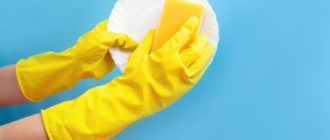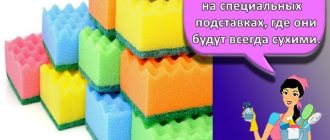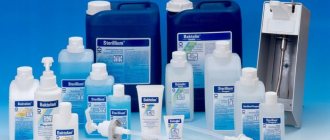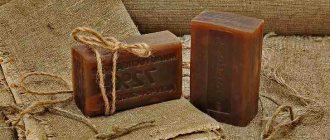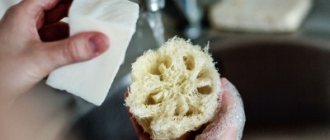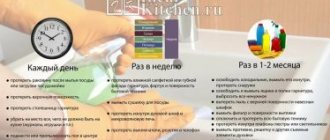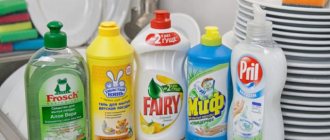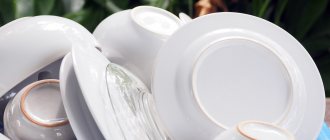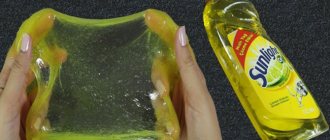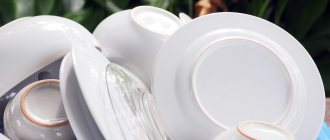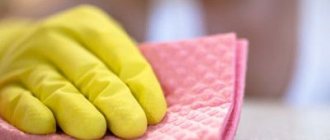Progress has given us many miracles, including a dishcloth without detergents. This invention is an excellent alternative to synthetic surfactants, which disrupt the ecological balance and can provoke allergies and skin diseases in humans.
Eco-friendly napkins are usually made from cotton and with the addition of bamboo fiber. Manufacturers promise the durability of such products and the ability to quickly tidy up not only the dishes, but also the sink. This cloth replaces a set of sponges, which quickly become unusable and lose their appearance after a week of use.
Rules for using the house
Using a Japanese napkin, you can easily get rid of any type of dirt in the house.
The embossed side is suitable for wiping countertops, refrigerators, doors, bathtubs, and sinks. Ribbed weaving is used for effective, but at the same time, gentle cleaning of heavy soiling: kitchen stoves and tiles, ovens, hoods, metal coatings and other surfaces. There are special wipes for glass that, without much effort, will make the windows completely transparent, without the slightest streak. This same irreplaceable material will help clean mirrors, crystal and other glass products to a shine. Before you start cleaning, you need to moisten a cloth with warm water, squeeze out excess moisture and start cleaning surfaces without using chemicals. If you need to remove dust, you can do this with a dry cloth. In this case, it works like a magnet, attracting dust particles. The surface remains clean for a long time.
The water temperature when washing should not be higher than sixty degrees. It must be dried at room temperature, but not on a radiator. With proper use, the napkin will last more than two years. Japanese cleaning wipes appeared relatively recently on the consumer market, but have already managed to please housewives and employees of cleaning companies.
Scope of use
Bamboo napkins are positioned as rags that are convenient for washing dishes, but in fact their scope of application is much wider. They are used:
- for washing windows and mirrors;
- to wipe away dust;
- for daily cleaning of surfaces (for example, a kitchen table);
- for the care of household appliances, kitchen stoves;
- for washing the sink.
When washing dishes, these napkins are excellent at removing grease. Buyers share reviews and say that they manage to wash almost any surface without using chemicals.
We recommend: Removing the smell of old age from your apartment using simple and reliable methods
True, according to the same users, after such an operation, hands may end up in grease, which transfers through the rag to the skin, so they have to be washed with soap.
Composition and properties
The secret to cleaning efficiency lies in the composition of the napkins. They are made of special thin threads made from polymers. These are polyamide and polyester. In the manufacture of canvas, extruders are used, into which the material is pressed through holes with the desired cross-section. Recently, the process has become more complicated due to the release of double thread. Thanks to this technology, matter turns out to be two-sided.
Using dissected microfiber, the napkin works on the principle of a pump. Absorbs moisture much better than regular fabric. Together with water, it seems to absorb dust, dirt, and grease, which is retained inside, between the fiber villi. Thanks to the double thread, one side of the napkin is smooth and soft, and the other is ribbed and hard.
What not to use
There is a strict taboo on certain products in the kitchen. They must not be used under any circumstances. These are aggressive solvents, abrasives and similar compounds.
Solvents
Plastics, polymer films, paint coatings are sensitive to the action of organic solvents. In order not to permanently spoil the surfaces of the countertops or facades, before using the product, you should study its composition indicated on the label. If the word “solvent” is there, you cannot use the reagent.
Nitroglycerine
A transparent liquid slightly reminiscent of oil in consistency cannot be used for cleaning the kitchen. It cannot eliminate pollution, and there will be no particular benefit from such an alternative. And the remaining oily stains will then be difficult to remove from the glossy surface.
Alcohol
Most alcohols, including ethyl alcohols, are solvents. Alcohol-containing liquids contribute to the destruction of the integrity of paintwork coatings and loss of gloss.
Polymer resins
Components of adhesives and varnishes, which are polymer resins, of course, cannot be used to clean coatings. In addition, if accidentally applied to a surface, they create the following problem: how to remove this composition from the coating.
Soda and salt
Generally harmless components, however, can cause serious harm if used inappropriately. Both soda and salt are mildly abrasive materials and will certainly leave scratches on glossy facades and destroy the shine of the coating.
What not to do
When wiping off dirt from the screen, you need to adhere to a number of rules. There are several actions that should not be performed as they may cause the device to malfunction.
Use liquid window cleaners
If the display does not have a special protective coating, it is prohibited to treat it with liquid window cleaners and solvents that contain chemical components. When exposed to these substances, the monitor is destroyed.
Clean switched on equipment
When starting cleaning, you need to turn off the TV. In this case, it is not enough just to press the shutdown button on the remote control. To ensure maximum safety when wiping equipment, you should completely turn off the power to the TV by removing the plug from the socket.
Use a fabric with lint
Use a soft, lint-free cloth to remove dirt. One option is microfiber, which is an all-purpose cloth for removing streaks, fingerprints and smudges. Microfiber has the property of absorbing moisture, so to remove large contaminants, it can be pre-moistened.
Wash with water
If the surface of the screen is not wiped with microfiber, it is prohibited to apply water or liquid products. This will cause a deterioration in the clarity of the transmitted image and the appearance of rainbow stains.
Do not scrape or scratch the surface
When wiping dust and dirt, do not apply force, press on the display or scratch it. Otherwise, noticeable scratches or cracks will remain on the surface.
Particular attention to LED surfaces
Varieties of equipment with an LED surface must be cleaned with extreme care. Even a slight mechanical impact can cause surface destruction.
Turn on until completely dry
Before turning on the device, you should wipe the screen dry or wait until traces of the cleaning agent have dried. This is necessary for safety reasons and to protect the display.
Additional Tips
Non-woven microfiber wet wipes are commercially available. The products are impregnated with a disinfectant solution and stored in packaging with a valve. Disposable products are necessary for wiping clean surfaces for disinfection. At home, you can use a roll of cleaning cloth used in car washes.
Technical material is made from:
- non-woven propylene;
- viscose;
- paper waste with cellulose.
The size of the napkin has no restrictions on length, which is convenient for wet cleaning of floors and wiping tiled walls. A piece of fabric of the required size is cut when using a mop. Manufacturers offer options for rubberized microfiber and cellulose fabrics, which extend the service life of products and improve the quality of cleaning surfaces from dirt. Each type of napkin has its own service life, after which the product loses its consumer qualities. Stains appear on surfaces and lint remains. You should follow the manufacturer's instructions regarding the method and duration of use.
Adviсe
Latex wipes must be slightly moistened before use (a dry rubberized surface wears out very quickly).
Bamboo household rags should not be dried on a radiator or near an open fire, or bleached with chlorine-containing compounds. Otherwise, bamboo fabric very quickly loses its beneficial properties.
Viscose napkins must be moistened before use. Dry twisting deforms viscose fibers, causing them to break down very quickly.
Properties and specifics of using porcelain stoneware
Sinks made from this material have the following advantages:
- Strength. During manufacturing, the product acquires additional hardness. Therefore, the material is often compared to natural stone.
- Persistence. Not afraid of exposure to household chemicals. Easily tolerates temperature changes.
- Environmentally friendly. Since the product is placed in the kitchen, it is constantly in contact with food and utensils. Porcelain stoneware consists of components that are not harmful to the human body.
- Aesthetics. This point is important for people who love non-standard solutions in the interior. With the help of a sink made of artificial stone, you can not only move away from monotony, but also create harmony and comfort.
Despite the advantages, a porcelain stoneware sink, just like a stainless steel sink, needs regular cleaning.
Usage
Porcelain tiles withstand direct contact with chemicals. But still, you should not expose the surface to aggressive mixtures.
If some of the chemical is on the surface, it must be removed as quickly as possible. Otherwise, the product will remain damaged. Composite stone is a durable and strong material. Falls, strong blows with a heavy object and cuts with a knife leave behind chips and cracks. Over time, the sink becomes covered with scratches, which are noticeable on dark-colored products. To prevent minor defects from causing severe damage, it is necessary to monitor the condition of the material.
Bamboo washcloths. Microreview from the category of amazing nearby.
Hi all! China never ceases to amaze me. And everyone is used to it when we see some ingenious things in the electronics section, but when I find some things useful in everyday life that I didn’t even know about, this leads directly to surprise at the resourcefulness of our Chinese friends. The first discovery for me was melamine sponges. Now I went further and swung at the bamboo rags. And I’ll say it right away. You need to take this! This is a must have in any kitchen. Anyone interested, welcome to cat. A few photos, mostly emotions. I came across this product by accident, I don’t even remember how exactly. Interested. I started googling harshly and found only very positive reviews. And she washes dishes without grease remover. And there is absolutely no nasty smell. And I’m not talking about Chinese parcel aromas, but about the smell that everyone felt in the kitchen when they left a damp table rag on the sink. This is what irritates me the most. We tried all kinds of rags, both cellulose and microfiber. All the same, after use, if you remember to wring it dry and dry it, the smell from them on the second day makes you throw the rag away. And I would live like everyone else, and would not think about anything new, until I came across this entry. I ordered it and waited.
The order took 23 days to reach me and was tracked. The seller immediately gives you the opportunity to choose “many” colors. This means that the rags are sent in random order, as the Chinese soul desires. Moreover, in the picture on the page there are different colors, but I received 4 white, 4 green and 4 blue rags. Supplied simply in a package. I didn’t take pictures of all of them in a bunch, because I like to review only products that I liked, and I don’t describe those that are not worthy of your attention. But I still didn’t know how to treat these rags, so I decided to test them first. But in general it comes something like this (photo from the Internet.)
There is a slight smell from the rags from the bag. I suspect that it smells like Chinese, but I can’t say for sure, I haven’t seen anyone up close :) It disappears in 2 days. And severe tests with kitchen and utensils began. After a month of use, only positive emotions remained. So much so that my mother-in-law took 3 pieces, my mother took 3 more, and my sister took one. I still have 5 rags left. A huge advantage of such rags is their durability. They can easily be washed and used further, so I think that these five will last me a long time. Here are the rags after 2-3 washes. They are absolutely passionate about the process of washing dishes.
They are terry cloth, like a towel.
My feelings from these rags are only positive. They wash dishes perfectly and really without using any detergent. What’s strange, but true, is that they wash away fat perfectly. The most powerful test for me is washing the plastic container I carry with me to work with my lunches. Does a great job. And let's move on to the most important thing for me. We test for table rubbing.
There is a huge disadvantage of these rags. They do a very poor job of absorbing water. (here I’ll make adjustments, they absorb perfectly, but not much, they get wet very quickly and stop absorbing.) This plays a positive role in terms of dishes and not retaining grease, but in wiping tables it plays a negative role. But everything is not criminal. You can go over it with a cloth a couple of times, it’s not scary. Then you rinse the cloth under water, wring it out without fanaticism, throw it on the fender of the sink, and no matter how long it sits there, THERE IS NO SMELL. Well absolutely. it's just wonderful. This really impressed me so much that this purchase became almost as useful as the video nanny camera from the previous review. The cloths have taken root in our kitchen and I will definitely buy them again. I don’t understand how I lived before this. I prepared this review not for the purpose of review, but for the purpose of introducing people to such a cheap and awesome thing. I understand that maybe I’m behind the times and many people know, but maybe this will be useful to someone. That's all. As a bonus, I prepared a small GIF that shows how a rag copes with the oven grate, only after barbecue.
They do a very poor job of absorbing water. (here I’ll make adjustments, they absorb perfectly, but not much, they get wet very quickly and stop absorbing.) This plays a positive role in terms of dishes and not retaining grease, but in wiping tables it plays a negative role. But everything is not criminal. You can go over it with a cloth a couple of times, it’s not scary. Then you rinse the cloth under water, wring it out without fanaticism, throw it on the fender of the sink, and no matter how long it sits there, THERE IS NO SMELL. Well absolutely. it's just wonderful. This really impressed me so much that this purchase became almost as useful as the video nanny camera from the previous review. The cloths have taken root in our kitchen and I will definitely buy them again. I don’t understand how I lived before this. I prepared this review not for the purpose of review, but for the purpose of introducing people to such a cheap and awesome thing. I understand that maybe I’m behind the times and many people know, but maybe this will be useful to someone. That's all. As a bonus, I prepared a small GIF that shows how a rag copes with the oven grate, only after barbecue.
Thank you all for your attention, happy shopping!
Why do streaks remain on glass?
Stains, stains and deposits remain on the glass after cleaning for many reasons. Even with perfect cleaning, unpleasant marks may remain. And the reasons for this phenomenon lie in the following factors:
- Cleaning in hot weather. Under the influence of direct sunlight, moisture quickly evaporates, which leads to the appearance of stains. It is for this reason that it is not recommended to clean windows in such weather.
- Incorrectly selected chemicals for washing. Some low-quality compounds may leave cloudy marks on the glass. In addition, abrasive particles can scratch windows and leave streaks.
- Incorrect cleaning method. Stains and stains may remain if all dust has not been removed from the windows first. Window cleaning is carried out in several stages, which are accompanied by the preparation of glass and the use of chemicals.
To wash a window without streaks and deposits, it is important to choose the right technology and cleaning products.
What not to use
Having decided to start cleaning the monitor, it is worth finding out what means can render it unusable, which is strictly prohibited from being used for this purpose.
Plain paper napkins
Towels that are used to wipe dishes after washing leave lint on a smooth surface, and it is almost impossible to remove them. Paper may cause scratches.
It is not recommended to rub stains on the monitor with wipes soaked in ethyl alcohol.
Rough cloth and towels
Rubbing with a hard material leads to cracks on the surface and, over time, damage to the screen. When cleaning a tablet or laptop with a towel, lint sticks.
Foam sponges
To prevent stains from appearing on the monitor, which will then take a long time to wash, you need to know that such surfaces cannot be wiped with foam rubber. The sponge sucks up dirt, crumbs, lint that scratches the screen and leaves marks.
Dish and glass cleaners
Liquids, gels, sprays that do an excellent job of removing grease on plates, removing coffee and tea stains, wiping dust on glass, are not suitable for cleaning monitors, but are intended for washing dishes and cutlery.
Sharp objects
Blades and knives remove traces of chewing gum and the presence of insects, but touching the screen damages the coating.
Scotch
It is not recommended to use adhesive tape used in everyday life to wipe dust on a laptop, since it sticks to the surface, and removing traces left by tape is not so easy.
Wet wipes for personal hygiene
Do not clean the monitor with a melanin sponge, embossed materials, or old cloth. Some items contain abrasive substances, while others shed lint. Sanitary napkins leave marks.
Alcohol
The displays of modern tablets and laptops are covered with a special film, which reduces the effect of the sun's rays and removes glare that degrades images. However, the structure of such material reacts negatively to ethyl alcohol, acetone or ammonia, which are present in glass cleaners and dishwashing gels.
How to use?
Washing dishes using special napkins is easy:
- The cloth is moistened with water, lightly wrung out, and a small amount of liquid detergent is applied.
- Wipe the contaminated surface.
- Wash off the soap solution along with grease and food particles from the dishes under running water.
- The napkin is washed, wrung out, and hung out to dry.
It is convenient to wash dishes in the following order: wash cups, plates and cutlery first, and then proceed to pots, pans and other kitchen utensils.
Popular products and liquids
To care for monitors, sprays and aerosols are produced that cope with any dirt, do not leave streaks, and do not damage the surface.
Cleaning wet wipes
Regardless of what you use to wipe the screen, it is worth disconnecting the computer from the network; moisture getting inside the case can cause a short circuit. Special napkins in plastic packaging, which are sold in technology departments:
- remove dust and dirt from the display;
- do not form divorces;
- do not scratch the surface.
You can wipe off stains with such products on the screen of a smartphone or TV. It is advisable to do wet cleaning every month.
Buro Bu – Tscrl
The company, which has been present on the Russian market for many years, supplies office equipment, chargers, and accessories for gadgets. Buro brand wet wipes perfectly clean stains on glasses and monitors and do not leave streaks.
Fellowers FS-99703
A Russian company that sells household and digital appliances and peripheral devices supplies stores with alcohol-free cleaning wipes.
Microfiber cloths
Polyester fibers are used to produce synthetic fabric that absorbs moisture and is highly durable. Microfiber napkins:
- cleans stains and dirt;
- repel dust;
- do not leave lint.
The products are impregnated with special components that are safe for LCD screens. Microfiber allows you to wash the surface of the display without streaks.
Spray
Companies that produce office equipment also create products that clean the surfaces of monitors from dirt, fingerprints, and dust.
Buro Bu Screen
A spray with an antibacterial effect is sold in 250 ml plastic bottles under the brand of a Russian company. The screen cleaner contains:
- nonionic active substances;
- propanol;
- antistatic.
The product is sprayed onto the surface and wiped with a napkin. When using it, streaks do not form and dust settles less.
Cactus CS-S3002
The spray of Russian origin gently cleans the surfaces of gadgets, keyboards, sprays well and dries quickly, and functions as an antistatic agent. The product is equipped with a dispenser, has no odor, is economical in use, and copes with dust and dirt.
Chemical-free cleaning cloths
Choosing the right cloth for cleaning without detergents will ensure high quality cleaning and safety for humans and the environment. The product will last for several years and retain its appearance. When purchasing, you should carefully study the instructions on the package. Read the purpose, service life, care instructions.
Top 3 brands for rags
Innovative napkins "Greenway" AQUAmagic. The company produces chemical-free home cleaning products. The base is Japanese cut microfiber.
AQUAmagic universal wipes clean all types of surfaces
- The AQUAmagic SPLITTER double-sided sponge for the kitchen removes stubborn grease from the oven and microwave from stuck fat.
- Universal wipes can absorb unpleasant odors. Quickly remove stains from clothes. Clean the outside of shoes from street dirt. The napkin is moistened and placed in the boots overnight; freshness and cleanliness are guaranteed in the morning. They will save upholstered furniture if it has been “marked” by a pet or something has been spilled.
- The AQUAmagic “Baby” baby care set allows you to clean and massage your child’s body without chemicals. Wipes ensure the cleanliness of toys, children's dishes, and furniture in the child's room.
- The set for car enthusiasts consists of a universal napkin, a napkin for glass, a mitten for cleaning seats, and a large napkin for washing the outside of the car. The AQUAmagic “Lux” car towel will wash a dirty car using 5 liters of water.
Napkins and rags made by HomeStar. New on the market. Suitable for wet and dry cleaning.
They are presented in assortment:
- Microfiber cloths make the cleaning process easier and faster thanks to their double-sided terry weaving. Ultra-fine microfibers remove dust and dirt from microcracks. Different types of napkins are sold: universal, for dishes, tiles, furniture, for cleaning the kitchen.
- Wipes containing bamboo remove grease from tiles, furniture, and stoves. The viscose in the composition provides soft care. Does not leave scratches or streaks. Dries quickly. Wash in running water.
- Viscose napkins are designed for any surface. The products are durable thanks to the polypropylene fibers in their composition. Therefore, they can be used with detergents and bleaches.
- Regenerated cellulose sponge wipes have antibacterial properties. Absorbs unpleasant odors. Suitable for cleaning kitchens and bathrooms. Washable in warm running water.
- Floor cloths made of microfiber and viscose.
The Bon Home cloth is suitable for caring for household appliances.
The Bon Home multifunctional cloth is made of bamboo fiber. Cleans all types of surfaces without detergents. Does not generate static electricity.
Washable with water and laundry soap. The product is available in several colors. This allows you, if desired, to use a separate cloth for a specific type of contamination. Convenient sized napkins. They are washed with laundry soap once a week by hand or in a washing machine. The undoubted advantage is the low price. The products are sold in stores in hardware departments, such as Fix Price.
Additional Information! Also popular on the market are cleaning accessories from the Swedish company Smart, mops and microfiber cloths from White cat, Sweden, and PROTEX wipes “Life without chemicals” from Sweden. You can buy chemical-free products made in Russia.
Types of pollution
Rags used to wipe dishes or cutlery are not suitable for cleaning the screen of a gadget; you should not spray the monitor with water or liquid for cleaning glass surfaces. How to wipe the display depends largely on the type of dirt.
Dust
Even if the floors are washed and cleaned daily, you still have to clean the monitor. Taking a piece of soft cloth or a dry sponge, you need to swipe the screen several times and this is enough to remove the settled dust.
Insect marks
Stains on the laptop are left by flies, midges that fly into the apartment through the window, and moths that live in cereals and flour. Traces are removed with a special napkin. To avoid scratching the screen, do not scrape off insect stains with a blade.
Mud tracks
It is not recommended to wash the monitor with water even when there are food residues, glue, or cosmetics on it, since the liquid flows into the compartments and openings. Old stains that cannot be removed with a napkin are cleaned with table vinegar and wiped dry with a rag.
Fat stains from fingers
To remove oil marks on a laptop or tablet monitor, a special liquid is sold in hardware stores. You cannot remove greasy stains with compounds that contain ethyl alcohol. It is better to wipe off the dirt with soap, but not with household soap, but with baby soap.
How to choose the right washcloth
Sponge rags, viscose rags, plain sponges, sponges with a coating that does not scratch Teflon, melamine sponges, bamboo rags. Head is spinning. But practice shows that not every rag will wash a greasy plate the first time. And sponges, although more convenient, are also more dangerous.
Sponges have a number of advantages. Firstly, they foam detergents better. Secondly, they wash off dried-on food residues better. Thirdly, they are compact, they fit into almost all corners. But with all this, sponges have several serious disadvantages: try to wipe a table with a sponge, and you will see for yourself the first drawback - they do not absorb water. And the second drawback is invisible, but much more formidable -
a host of all kinds of bacteria that multiply in the moist and porous environment of the sponge at a fantastic speed.
With a rag, everything is similar - it has a number of advantages, but there are also a number of disadvantages, so in the kitchen it is better to use a rag (also called an absorbent napkin) and a sponge in pairs. But since our housewives still pick up a rag more often, let’s try to conduct a series of tests and choose the most suitable rag for household needs.
There are several types of rags on the market in different price categories. The most common and, it is believed, the most convenient are sponge napkins made of cellulose and cotton, which absorb liquid well, do not leave lint on the surface being cleaned and last a long time (withstand up to 25 washes at 60 degrees).
In the package, as a rule, they are already wet, that is, they are immediately ready for use. By the way, it is also important to point out that when dry, these rags turn into wrinkled shells and can only work when moistened.
The second type of rags for washing dishes (as well as a variety of household needs) are viscose-polyester-polypropylene rags, which are much thinner than their cellulose-cotton friends and have less durability. But they are suitable not only for washing dishes, but also for dry cleaning - for example, wiping off dust. When wet, they behave poorly - for example, wiping the tabletop dry with a viscose cloth will not work -
tiny droplets of water will still remain. An absorbent napkin does not allow this to happen.
We bought 10 types of napkins from different manufacturers and tried to choose the best option. We bought both very cheap options (McLean universal napkins for 0.64 euros for 5 pieces) and expensive ones (Vileda Power Lines for 2.39 for 3 pieces).
And we checked them on six points: - for hygroscopicity (absorbability) - poured 100 ml of water on the countertop; — dry trace (how much moisture the cloths will leave behind on the table surface); — removal of grease (we will wash off grease from dishes without using cleaning products); - scrubbing away old stains; — rubbing off a fresh stain (for example, from ketchup); - strength (pressed and pulled in different directions).
During the testing process, two leaders were identified - Scotch-Brite and Wettex. Both manufacturers pleased us with excellent products, but when it came to determining the finalist, it was decided to choose the cheapest option.
During the calculation process, it turned out that they cost the same, so the consumer can choose either a package with a set of three pieces measuring 18x20 cm (Scotch-Brite), or individually, but with a slightly larger area - 20x26 cm from Wettex.
The entire article is in the weekly magazine “MK-Estonia”.
Storage and care
There are also certain rules regarding the storage and care of mittens that should be followed if you want the products to serve you for a long time.
- It should be stored at a temperature range from +5 to +25 degrees, while the room should also have moderate or low humidity.
- You should not leave the product in the sun for a long period, as the materials from which they are made may lose their protective properties, and sometimes can even melt. The same rule applies to heating devices: do not dry your gloves on the radiator.
- After each use, the item must be rinsed under running water to remove dirt, as well as chemical residues that tend to seep inside.
- If the inside of the product is covered with cotton, it must be rinsed from the inside after use. Such manipulation is necessary to ensure that certain organic residues do not accumulate in the specified coating, since in the future they can cause irritation of the skin.
Share link:
How to extend the life of napkins and rags
Manufacturers guarantee a service life of 2-5 years (depending on the quality of raw materials and production technologies). But chemical-free cloths need proper care. For this purpose, clear instructions for use are included. Pay attention to the following points:
- What kind of water to wash them in (warm or cold).
- Washing mode (hand, in washing machine, both options). Is it permissible to wash in hot water?
- Is it necessary to rinse after each use?
- How to dry and where to store products.
Most microfiber cloths cannot be washed with synthetic detergents. Harmless laundry soap will do. Do not dry on a radiator or in the open sun.
Traditional methods
A number of traditional methods are not inferior to the use of special substances. Using available means, you can effectively remove dirt from the screen without damaging it.
Vinegar
A safe substance for wiping an LCD monitor is a solution of vinegar with a concentration of 3%. Instructions for use are as follows:
- vinegar essence is mixed with cold water in equal proportions;
- Dip a soft cloth into the solution and wipe the display in a circular motion;
- Wash away any remaining essence with a clean, dry cloth;
- wipe the screen dry.
Soap solution
If you need to remove other contaminants in addition to dust, it is recommended to make a soap solution. Any soap is suitable for this purpose, with the exception of laundry soap. Dissolve the soap in water, moisten a rag in the resulting solution and gently wipe the TV. Then wash off the soap stains and wipe the display dry.
Isopropyl alcohol
Dried particles of dirt and fingerprints can be removed using isopropyl alcohol with a concentration of 70%. The substance is diluted in cold water, maintaining equal proportions, a napkin is soaked in the solution, squeezed out and wiped the screen.
Types of material
Leather bags are made from several types of material.
Smooth natural leather
Most often, when making bags, they use smooth natural leather, which has a perfectly smooth texture. It is made from the skins of sheep, bulls, goats and calves. The advantages of this material include its strength, reliability, durability and resistance to moisture.
Soft skin
Some girls buy themselves handbags made of soft leather. This material goes through a special grinding process, which gives it a unique appearance. After treatment, the surface becomes very soft and elastic.
Velours
Velor is a leather material that has been pre-chrome tanned. When creating velor, double-sided sanding is carried out to make the surface smoother. Many people confuse this material with suede, as they are very similar.
Polished leather
The main difference between this material and other types of leather is its shiny glossy coating treated with varnish. The quality of patent leather depends on the manufacturing technology. When creating the material, the skins are first treated with a special primer and then varnished.
Faux leather
Nowadays, many handbags are made not from natural, but from artificial leather. These materials are very similar in appearance and therefore difficult to distinguish between them. The main differences include the quality of the products and their cost. Budget models of women's bags are made from leatherette.
Reptile leather or embossed
Embossed leather is leather that has a unique pattern on its surface. Most often, such leather coverings are given the appearance of the original skin of snakes, crocodiles and other reptiles. Products made from this material are dense and expensive.
Compound
Bamboo napkins are fabrics made of non-woven material, for the production of which natural raw materials are used. Their main feature is their special structure: these are porous-tubular rags.
The size, price and color of napkins depend solely on the imagination and desires of the manufacturer. The buyer can choose according to his taste either options from China, which are attractive at a low price, or European and Russian analogues, which are of higher quality and durability.
Despite the name, bamboo placemats are not made from bamboo fibers. First, the wood is converted into cellulose, and then threads are made from this raw material. To prevent them from being very hard, they are treated with sodium hydroxide. In some cases, the manufacturer dilutes the bamboo with cotton by 50%.
Types and features of coatings
Manufacturers of kitchen sets and countertops successfully combine various materials. Most often it is chipboard or MDF, laminated (painted). Acrylic paint coatings compete with plastic, and decorating with cheap PVC film helps change the appearance beyond recognition. This is how moisture-resistant, durable stone, natural wood, and futuristic slabs are created.
Each material has both strengths and weaknesses. Accordingly, specific cleaning agents are used for them.
Plastic
The use of cheap, durable and unpretentious plastic elements in the manufacture of furniture minimizes the risk of somehow damaging cabinets and cabinets if handled carelessly. Polymers are not afraid of water, can withstand contact with hot dishes, and do not fade
Another advantage of the material is the low weight of plastics: in comparison with metal and wood, they are much lighter, without loss of overall rigidity and reliability.
Dye
The traditional method of processing facades is painting, used to create durable, abrasion-resistant coatings on the surfaces of pressed MDF boards. According to the technology, a paint layer is first applied, and then a varnish is applied (to create a glossy effect). Some difficulties lie in the increased requirements for preparing the base: the absence of potholes, gaps, and roughness. This is ensured by repeated grinding of the material with abrasives and sandpaper.
PVC film
A polymer film applied to the surface of the material by pressing is a budget solution. The consumer can choose white, blue, red, black and other colors to his taste, of which the manufacturer has plenty in stock.
The advantages of the material are wear resistance, strength, and low cost.
Acrylic
Acrylic materials are polymer materials, which means they are fully endowed with the advantages and disadvantages of plastics. The method of applying a layer of plastic to the main surface is gluing. The coating is durable and easy to maintain.
But when choosing a detergent, you should avoid aggressive compounds - they will destroy the gloss of the surface.
Painted MDF with varnish
MDF is considered a hygroscopic material; without special protection, the board quickly becomes saturated with moisture and collapses. To do this, it is painted and coated with a special varnish. The coating will protect MDF, but at the same time it is sensitive to abrasives and aggressive compounds.
Rating of safe products
People who have suffered from allergies for years, have small children, or simply care about the preservation of the ecosystem for future generations, try to choose the safest laundry detergents.
MaKO Clean
Russian children's washing powder that does not contain phosphate, chlorine, or aromatic fragrances. Suitable for all types of laundry, hand and machine washable. Does not cause allergic reactions, does not generate dust when poured, economical (55 grams per wash). Available in environmentally friendly, biodegradable packaging.
Ecover
A line of Belgian phosphate-free products. Completely decomposes without harming nature. Chlorine, fragrances and phosphates are completely absent from this washing powder. After washing, things are soft and do not require the use of conditioner.
Ecodoo
Ecodu is a line of French home care products. Washing powder is safe for hands, hypoallergenic and economical. It contains no preservatives, dyes, or phosphates. The base is Aleppo soap, a mixture based on olive oil and laurel fruit extract.
BioMio Color
Russian phosphate-free powder for colored laundry. Refreshes color, is economically used, suitable for newborns, pregnant women and users prone to allergic reactions.
Klar EcoSensitive
German washing powder based on soap nuts, suitable for white fabrics and items with strong colors. Instead of phosphates, it contains zeolite - a substance that is safer than phosphates. Suitable for asthmatics and allergy sufferers. No fragrance. It is easily removed from fabric fibers when rinsed. Washing gel is also available.
What are they?
On the shelves of hardware stores you can see a large variety of dishcloths, each of which has its own special purpose and unique properties.
Microfiber
The leader in the popularity rating is a microfiber cloth. This synthetic material, woven from the finest fibers, helps to quickly clean any dirt from dishes. Microfiber, like a scraper, collects dirt . The smallest fibers penetrate into the grooves on the surface, providing high quality cleaning.
Microfiber towels are durable (withstand up to three hundred washes at 60C). Microfiber can be washed either by hand or in a washing machine.
Made of latex
The rubberized surface of latex wipes copes well with any, even old, stains. The inner layer of viscose retains detergent, providing impeccable dishwashing performance.
After use,
latex cloths are washed in soapy warm water, rinsed, and hung out to dry .
Made from bamboo
The bamboo fibers from which the wipes are made help achieve the desired cleanliness result with virtually no need for detergents. The thing is that bamboo fibers (which look like tubes) attract fat molecules, food particles and other contaminants, and then, when rinsing, leave the collected dirt in the water.
Bamboo napkins:
- Ideal for caring for glass, crystal, and glossy dishes (they do not leave streaks or lint after use).
- Do not cause an allergic reaction upon prolonged contact with the skin of the hands.
- Cleanses from fat, eliminates unpleasant odors, spores and fungus.
After each use, bamboo rags must be washed in a soapy solution (it is better to use laundry soap), rinsed under running water, and then hung out to dry.
Viscose
These inexpensive, brightly colored placemats have a permanent place on the kitchen sink. Soft and pleasant to the touch, they perfectly absorb liquid and hold dishwashing detergents.
Viscose napkins are extremely practical. They are great for both washing glassware and cleaning metal kitchen utensils. After use, napkins must be rinsed under running hot water and hung out to dry (viscose dries very quickly).
For washing without detergents
This is a special type of napkin made from very thin fibers, cut into several parts. It is due to the numerous gaps in the fibers that the capillary effect of the nonwoven material is ensured (the ability to quickly attract and retain any contaminants).
Cleaning cloths without detergents are an ideal option for caring for glass and crystal dishes . They do not absorb foreign odors and are suitable for everyday use. Sponge wipes remove not only dirt, but also bacteria, mold spores, and mildew.
A special napkin will quickly and efficiently clean a greasy surface under running hot water. To remove stubborn dirt (traces of tea, coffee, particles of burnt food), wipe the dishes with a damp cloth several times.
Read more in this article.
How to wash windows and glass
Polishing with smooth microfiber
Washing windows is a labor-intensive process. They should be transparent, free from stains and dirt, and transmit light well. Chemical detergents leave cloudy marks, and abrasive particles scratch the surface of glass and window sills. Some housewives add ammonia to the water, which causes spasm of the respiratory tract and is especially harmful for asthmatics. You can use regular cotton or flannel rags. But you will need a large amount of water, sprays and special liquids for washing glass.
A special cloth for cleaning windows without detergents will help you wash your windows. It is recommended to choose products made from microfiber or microfiber with a porous structure. They absorb moisture well and do not leave streaks or lint.
Note! Synthetic suede cloths can also clean glass without chemicals. Due to their porous structure and corrugated surface, they work well
There is no need to additionally wipe with a dry cloth.
The principle of operation of special cleaning rags
These napkins and rags are made of special thin fibers that have increased absorbency. Rags made from Japanese microfiber have a capillary effect. Some have built-in silver ions to disinfect surfaces being treated. Other innovative cleaning products are made from cotton mixed with bamboo fiber and have a porous tubular structure. Non-woven material is used for production. Chemical-free cleaning cloths absorb grease and dirt stronger than usual.
Housewives use chemical-free cloths to clean the kitchen
New smart products replace classic dish sponges, which quickly become greasy and become unusable. Rags and rags from old things smell unpleasant after cleaning and need to be washed using chemicals.
Innovative wipes are moistened with water and wiped dirty surfaces. They effectively remove grease, dirt, and carbon deposits from frying pans and stoves. They don't leave streaks.
Note! A room cleaner only needs 1 universal rag to quickly clean up the mess. For a more thorough approach, it is worth buying a set of special products.
Assortment of cleaning products
There are various types of chemical-free products for successful and quick cleaning in the house:
- universal napkins;
- wipes for washing and disinfecting dishes;
- glass wipes;
- care mittens;
- discs for processing hard-to-reach places;
- kitchen cleaning sponges;
- mops for cleaning floors and other surfaces.
Special means
The use of special products, which are produced in the form of gel, foam and aerosol, helps to improve the effect of cleaning the screen. The substances remove various contaminants and leave an antistatic effect. When purchasing a cleaning product, you need to make sure that it does not contain alcohol.
Gel
Gel-like substances are easy to apply and do not leave streaks when wiping the monitor. A small amount of gel is squeezed onto a rag and the entire surface of the TV is treated.
Foam
Foam is suitable for removing difficult-to-remove stains. It is possible to clean the screen using foam without streaks or residues.
Aerosol
Apply the cleaning aerosol directly to the display or onto a cloth and wipe the surface in a circular motion. The aerosol is convenient to use for processing large diagonal screens.
Tips for choosing cleaning wipes
Before purchasing cleaning wipes, you need to pay attention not only to their price and size, but also to the materials. The quality of cleaning depends on this indicator. Let's look at the types of napkins depending on their area of application:
- Kitchen. Grease stains often appear here. Products made from bamboo and cellulose will cope well with this kind of pollution.
- Tile and plumbing. The surface of such materials is glossy and limescale often forms on it. In this case, it is better to choose cellulose napkins.
- Floor. For high-quality floor cleaning, it is necessary to meet the following conditions: remove dirt, dust and small debris, and also not leave streaks or wet marks. Products made of viscose and microfiber cope well with such tasks.
- Furniture. The main selection criterion is the removal of dust, including from small recesses, as well as the possibility of polishing. For this type of cleaning, you should give preference to microfiber cloths, and for wet cleaning - cellulose.
- Glass and mirrors. When applying gloss, it is necessary not only to remove dirt, but also not to leave any traces, including lint. To do this, it is better to buy a microfiber product without lint or with short nap. You can also purchase a cloth made of faux suede.
- Appliances. Dust quickly accumulates on it, as it attracts it. Therefore, for dry cleaning, use viscose rags. It will additionally relieve static tension and reduce the formation of dust on equipment.
